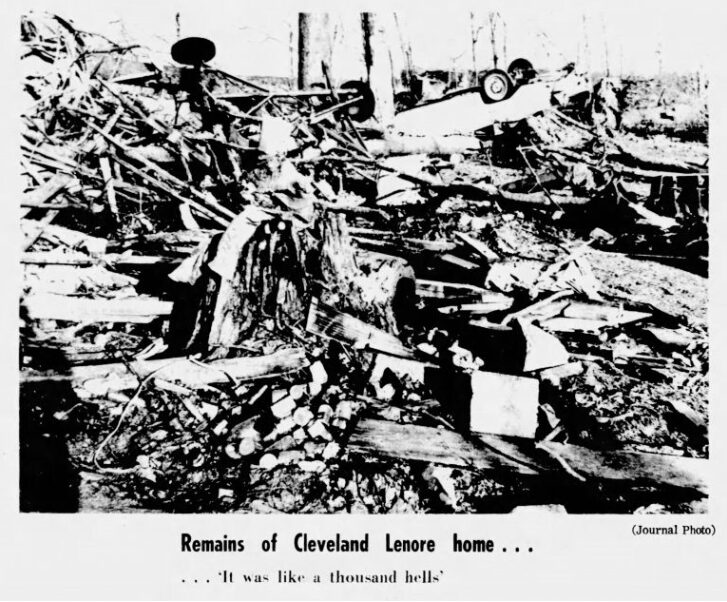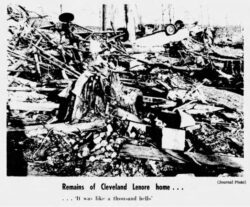Parish Spotlight
The Day of a Thousand Hells
The 1971 EF-5 tornado that struck near Delhi, Louisiana
Published: May 30, 2025
Last Updated: August 29, 2025

The Madison Journal in Tallulah, Louisiana (1971) via Wikimedia Commons
A newspaper excerpt from The Madison Journal shows extensive damage to the Lenore family home. All ten of Louisiana’s fatalities caused by the tornado were members of the Lenore family.
In the early morning hours of February 21, 1971, Bill Keating reported to work at the National Weather Service Bureau in Shreveport. The forecast was typical for February in North Louisiana: warm southerly winds, thunderstorms, scattered showers. But he made note of a low pressure system moving east across South Central Texas that had a cold front following behind. As the morning wore on, Keating became increasingly certain the cold air mass from Texas would hit the warm air near the northeast border of Louisiana—a recipe for tornadoes. He issued a tornado watch for northeastern Louisiana and northwest Mississippi, just before noon.
Within a few hours, the two air masses collided exactly where Keating predicted they would. In the town of Delhi, Louisiana—a small community of under three thousand people, less than forty miles from Louisiana’s northeast border—the sky grew dark, and the wind began to howl. Keating knew it was only a matter of time before the funnel clouds descended.
At about 3:20 pm, a large tornado touched down just southeast of Delhi. It was the first of dozens of tornadoes that would strike that day across northeast Louisiana and the Mississippi Delta region.
Willie Young, a railroad worker, was in the area with his family when the funnel met the earth, and acted quickly to move his family to safety under a bridge. Young later told a reporter that “it looked like a thousand hells.”

A headline in The Shreveport Times on February 28, 1971 referring to the tornado that struck North Louisiana a week prior. © Shreveport Times – USA TODAY NETWORK via Imagn Images
Joe’s Bayou Road
Just a few miles southeast of Delhi was a small settlement lining the banks of Joe’s Bayou, on a road of the same name. There stood a small sharecropper’s hut inhabited by the Lenore family. Ten of the thirteen family members were at home that Sunday; the other three were out of town.
The hut stood no chance against the tearing winds; it was shredded to a pile of sticks and strewn across a few hundred yards in a matter of seconds. Six members of the Lenore family were immediately thrown to their deaths during the storm They landed in a field at least two hundred yards away, across the bayou from the hut. One was sent to the hospital with severe injuries to his back, and others were missing for days. A family inside a vehicle nearby narrowly escaped with their lives, moments before the tornado picked up the car and tossed it atop the fresh ruins of the Lenore home.
As the enormous tornado tore through the area, several barns and six other homes were damaged near Delhi. The Zion Pilgrim Missionary Baptist Church near Waverly was reduced to rubble, only half an hour after the Sunday congregation was dismissed.
The tornado continued on through miles of uninhabited forest before hitting the small settlement of Melbourne, which sat between Transylvania and Alsatia. Several homes and trailers were destroyed there, and the twister pulled apart a mature pecan grove before it jumped across the Mississippi River, where it went on to terrorize Cameta, Delta City, and Isola, and to virtually level the town of Inverness. The tornado that began at Delhi is often referred to as the Inverness tornado, due to the sheer amount of damage it caused there.
The sky grew dark, and the wind began to howl. Keating knew it was only a matter of time before the funnel clouds descended.
Aftermath
After the storm cleared in Delhi, officials closed Highway 80, clogged with tree debris and fallen telephone poles. Joe’s Bayou, heavy with downed limbs, was dredged by the Tallulah Fire Department over several days in an effort to locate the missing members of the Lenore family. By the Thursday after the disaster, the dredging had only resulted in one recovered body: a six-year-old boy.
The tornado killed a total of forty-eight people on its 105-mile warpath across the two states, and all ten of its Louisiana fatalities were members of the Lenore household. Of the thirteen people who resided there, the only survivors were the three who weren’t home when the tornado struck: the head of household Cleveland Lenore Sr., and two sons, Ronnie and Cleveland Jr.
A Historic Tornado Outbreak
While the Delhi tornado raged northeastward, at least two other major tornadoes spawned nearly simultaneously across the river in Mississippi, going the same direction. Both F4 tornadoes tore a strip of mayhem across Mississippi, destroying the towns of Cary and Little Yazoo and many plantations along the way, while claiming lives throughout.
This streak of tornadoes in February 1971—often called the Mississippi Delta tornado outbreak—caused roughly $19 million in damage (more than $147 million when adjusted for inflation), and weather experts pointed out that these tornadoes were stronger and longer lived than most. Allen Pearson, Director of the Severe Storm Forecast Center in Kansas City at the time, flew over Louisiana and Mississippi several days after the outbreak. He realized that of the fifty to sixty tornadoes spotted in the area, only a few were responsible for most of the damage—and that only one was responsible for the 160 miles of destruction from Delhi to Inverness. According to Pearson, most tornadoes travel less than two miles before they dissipate. “It was some hundred-times stronger than an average tornado,” he later told a reporter.
Pearson collaborated with meteorologist Ted Fujita later that year to introduce the Fujita scale for ranking tornadoes from F-0 to F-5, with F-5 meaning “incredible” damage and wind speeds above 260 miles per hour. The Fujita scale was later replaced with the Enhanced Fujita scale that accounts for the amount of damage caused by a tornado, with rankings from EF-0 to EF-5. The Delhi tornado remains the only F-5/EF-5 tornado to ever hit Louisiana.
Christie Matherne Hall writes about foodways, culture, travel, and natural disasters for 64 Parishes and Country Roads. She is also a podcast producer for the Western Colorado Writers’ Forum and enjoys helping people write their memoirs through the Story Terrace platform.
